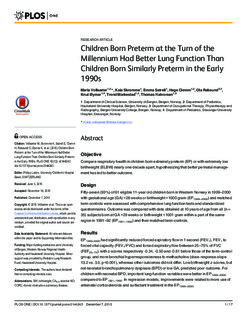| dc.contributor.author | Vollsæter, Maria | |
| dc.contributor.author | Skromme, Kaia | |
| dc.contributor.author | Satrell, Emma Elsa Carolina | |
| dc.contributor.author | Clemm, Hege Synnøve Havstad | |
| dc.contributor.author | Røksund, Ola Drange | |
| dc.contributor.author | Øymar, Knut | |
| dc.contributor.author | Markestad, Trond | |
| dc.contributor.author | Halvorsen, Thomas | |
| dc.date.accessioned | 2018-02-01T15:10:17Z | |
| dc.date.available | 2018-02-01T15:10:17Z | |
| dc.date.issued | 2015 | |
| dc.identifier.citation | PLoS ONE 2015, 10:e0144243(12) | |
| dc.identifier.issn | 1932-6203 | |
| dc.identifier.uri | http://hdl.handle.net/11250/2482030 | |
| dc.description | - | |
| dc.description.abstract | OBJECTIVE: Compare respiratory health in children born extremely preterm (EP) or with extremely low birthweight (ELBW) nearly one decade apart, hypothesizing that better perinatal management has led to better outcome. DESIGN: Fifty-seven (93%) of 61 eligible 11-year old children born in Western Norway in 1999-2000 with gestational age (GA) <28 weeks or birthweight <1000 gram (EP1999-2000) and matched term-controls were assessed with comprehensive lung function tests and standardized questionnaires. Outcome was compared with data obtained at 10 years of age from all (n = 35) subjects born at GA <29 weeks or birthweight <1001 gram within a part of the same region in 1991-92 (EP1991-1992) and their matched term-controls. RESULTS: EP1999-2000 had significantly reduced forced expiratory flow in 1 second (FEV1), FEV1 to forced vital capacity (FEV1/FVC) and forced expiratory flow between 25-75% of FVC (FEF25-75), with z-scores respectively -0.34, -0.50 and -0.61 below those of the term-control group, and more bronchial hyperresponsiveness to methacholine (dose-response-slope 13.2 vs. 3.5; p<0.001), whereas other outcomes did not differ. Low birthweight z-scores, but not neonatal bronchopulmonary dysplasia (BPD) or low GA, predicted poor outcome. For children with neonatal BPD, important lung-function variables were better in EP1999-2000 compared to EP1991-1992. In regression models, improvements were related to more use of antenatal corticosteroids and surfactant treatment in the EP1999-2000. CONCLUSIONS: Small airway obstruction and bronchial hyperresponsiveness were still present in children born preterm in 1999-2000, but outcome was better than for children born similarly preterm in 1991-92, particularly after neonatal BPD. The findings suggest that better neonatal management not only improves survival, but also long-term pulmonary outcome. | |
| dc.language.iso | eng | |
| dc.rights | Navngivelse 3.0 Internasjonal | |
| dc.rights.uri | http://creativecommons.org/licenses/by/3.0/deed.no | |
| dc.title | Children born preterm at the turn of the millennium had better lung function than children born similarly preterm in the early 1990s | |
| dc.type | Peer reviewed | |
| dc.type | Journal article | |
| dc.date.updated | 2016-11-04T09:16:01Z | |
| dc.identifier.doi | 10.1371/journal.pone.0144243 | |
| dc.identifier.cristin | 1305842 | |

